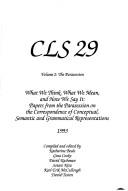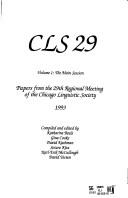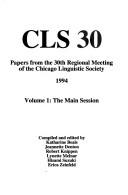| Listing 1 - 8 of 8 |
Sort by
|
Book
ISBN: 1614516456 1614519250 9781614516453 9781614519256 9781614517580 1614517584 Year: 2016 Publisher: Boston, [Massachusetts] ; Berlin, [Germany] : De Gruyter,
Abstract | Keywords | Export | Availability | Bookmark
 Loading...
Loading...Choose an application
- Reference Manager
- EndNote
- RefWorks (Direct export to RefWorks)
This book draws on the recent remarkable advances in speech and language processing: advances that have moved speech technology beyond basic applications such as medical dictation and telephone self-service to increasingly sophisticated and clinically significant applications aimed at complex speech and language disorders. The book provides an introduction to the basic elements of speech and natural language processing technology, and illustrates their clinical potential by reviewing speech technology software currently in use for disorders such as autism and aphasia. The discussion is informed by the authors' own experiences in developing and investigating speech technology applications for these populations. Topics include detailed examples of speech and language technologies in both remediative and assistive applications, overviews of a number of current applications, and a checklist of criteria for selecting the most appropriate applications for particular user needs. This book will be of benefit to four audiences: application developers who are looking to apply these technologies; clinicians who are looking for software that may be of value to their clients; students of speech-language pathology and application development; and finally, people with speech and language disorders and their friends and family members.
Communicative disorders --- Assistive computer technology. --- Speech processing systems. --- Communication devices for people with disabilities. --- Augmentative communication devices --- Communication aids for people with disabilities --- Communication devices for the disabled --- People with disabilities --- Self-help devices for people with disabilities --- Computational linguistics --- Electronic systems --- Information theory --- Modulation theory --- Oral communication --- Speech --- Telecommunication --- Singing voice synthesizers --- Accessible computing technology --- Adaptive computing --- Adaptive computing technology for people with disabilities --- Assistive computing technology --- Barrier-free computing technology --- Computers and people with disabilities --- Communication disorders (Medicine) --- Disorders of communication --- Nervous system --- Patients --- Rehabilitation. --- Means of communication --- Diseases --- Language software, linguistic technology, language-impaired technology, autism-enabled software, aphasia-enabled software. --- Speech processing.
Multi
ISBN: 9781614516453 9781614519256 9781614517580 1614516456 1614519250 Year: 2016 Publisher: Boston, [Massachusetts] ; Berlin, [Germany] : De Gruyter,
Abstract | Keywords | Export | Availability | Bookmark
 Loading...
Loading...Choose an application
- Reference Manager
- EndNote
- RefWorks (Direct export to RefWorks)
This book draws on the recent remarkable advances in speech and language processing: advances that have moved speech technology beyond basic applications such as medical dictation and telephone self-service to increasingly sophisticated and clinically significant applications aimed at complex speech and language disorders. The book provides an introduction to the basic elements of speech and natural language processing technology, and illustrates their clinical potential by reviewing speech technology software currently in use for disorders such as autism and aphasia. The discussion is informed by the authors' own experiences in developing and investigating speech technology applications for these populations. Topics include detailed examples of speech and language technologies in both remediative and assistive applications, overviews of a number of current applications, and a checklist of criteria for selecting the most appropriate applications for particular user needs. This book will be of benefit to four audiences: application developers who are looking to apply these technologies; clinicians who are looking for software that may be of value to their clients; students of speech-language pathology and application development; and finally, people with speech and language disorders and their friends and family members.

ISBN: 0914203436 Year: 1993 Publisher: Chicago (Ill.): Chicago linguistic society
Abstract | Keywords | Export | Availability | Bookmark
 Loading...
Loading...Choose an application
- Reference Manager
- EndNote
- RefWorks (Direct export to RefWorks)

ISBN: 0914203428 Year: 1993 Publisher: Chicago (Ill.): Chicago linguistic society
Abstract | Keywords | Export | Availability | Bookmark
 Loading...
Loading...Choose an application
- Reference Manager
- EndNote
- RefWorks (Direct export to RefWorks)

ISBN: 0914203452 0914203460 Year: 1994 Publisher: Chicago (Ill.): Chicago linguistic society
Abstract | Keywords | Export | Availability | Bookmark
 Loading...
Loading...Choose an application
- Reference Manager
- EndNote
- RefWorks (Direct export to RefWorks)
Book
ISBN: 9789027255594 9789027287120 9027287120 1283093162 9781283093163 9027255598 9786613093165 6613093165 Year: 2011 Publisher: Amsterdam [Netherlands] ; Philadelphia [Pa.] : John Benjamins Pub. Co.,
Abstract | Keywords | Export | Availability | Bookmark
 Loading...
Loading...Choose an application
- Reference Manager
- EndNote
- RefWorks (Direct export to RefWorks)
Autolexical Grammar (AG) explains both the coherent systematicity and the pervasive idiosyncrasies present in natural language through a unified, multimodular approach moderated by lexical constraints. This chapter presents recent research in cognitive neuroscience that bears on the representational strengths of AG. While AG does not strive to be a psycholinguistic model of cognitive processing in real time, the ability of AG to represent mismatch and resolution as formal constraints, and the emphasis that AG places on the lexicon as the moderating factor in constraint satisfaction, provides descriptive mechanisms that can further illuminate cognitive approaches to language processing.
Autolexical theory (Linguistics). --- Grammar, Comparative and general --- Hierarchy (Linguistics). --- Pragmatics. --- Syntax. --- Autolexical theory (Linguistics) --- Hierarchy (Linguistics) --- Stratification (Linguistics) --- Hierarchies --- Linguistic analysis (Linguistics) --- Linguistics --- Compositionality (Linguistics) --- Generative grammar --- Language and languages --- Syntax --- Pragmalinguistics --- General semantics --- Logic, Symbolic and mathematical --- Semantics (Philosophy) --- Philosophy --- Philology --- Grammar, Comparative and general Syntax
Book

ISBN: 1598572628 1598575562 Year: 2013 Publisher: Brookes Publishing
Abstract | Keywords | Export | Availability | Bookmark
 Loading...
Loading...Choose an application
- Reference Manager
- EndNote
- RefWorks (Direct export to RefWorks)
Digital

ISBN: 9781400885602 9780691175294 Year: 2017 Publisher: Princeton, N.J. Princeton University Press
Abstract | Keywords | Export | Availability | Bookmark
 Loading...
Loading...Choose an application
- Reference Manager
- EndNote
- RefWorks (Direct export to RefWorks)
| Listing 1 - 8 of 8 |
Sort by
|

 Search
Search Feedback
Feedback About UniCat
About UniCat  Help
Help News
News